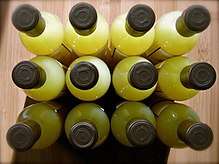Limoncello
Limoncello (Italian pronunciation: [limonˈtʃɛlːo]) is an Italian lemon liqueur mainly produced in Southern Italy, especially in the region around the Gulf of Naples, the Sorrentine Peninsula and the coast of Amalfi, and islands of Procida, Ischia, and Capri.[1] It is also produced in Calabria, Abruzzo, Basilicata, Apulia, Sicily, Sardinia, Liguria, Menton in France, and the Maltese island of Gozo. In northern Italy, the liqueur is often referred to instead as limoncino. It is also a popular homemade liqueur, with various recipes available online and in print.
 Homemade limoncello | |
| Alternative names | Limoncino |
|---|---|
| Type | alcoholic beverage |
| Place of origin | Italy |
| Main ingredients | Water, lemon zest, rectified spirit, sugar |
Although there is debate about the exact origin of the drink, it is at least one hundred years old.[2][3]
Limoncello has usually a slightly turbid appearance, which originates from the presence of small (approx. 100 nanometers) essential oil droplets suspended in the drink.[4] The spontaneous emulsification of hydrophobic essential oils in alcohol/water mixtures is often referred to as the ouzo effect.
Production
Traditionally, limoncello is made from the zest of Femminello St. Teresa lemons, also known as Sorrento or Sfusato lemons.[3][5] Lemon zest, or peels without the pith, is steeped in rectified spirit until the oil is released. The resulting yellow liquid is then mixed with simple syrup. Varying the sugar-to-water ratio and the temperature affects the clarity, viscosity, and flavor. Opaque limoncellos are the result of spontaneous emulsification (otherwise known as the ouzo effect) of the sugar syrup and extracted lemon oils.
Popularity

Limoncello is the second most popular liqueur in Italy after Campari[5] and has recently become popular in the United States, Canada, the United Kingdom, Australia, and New Zealand, where restaurants are now increasingly offering limoncello on their beverage and dessert menus.
The United States has seen a rise in commercial producers using California lemons which are grown year round, with 90% of the United States lemon crops coming from California. A popular ingredient in cocktails, limoncello imparts a strong lemon flavor without the sourness or bitterness of pure lemon juice.
In the UK, limoncello is also called lemoncello.
Serving
Limoncello is traditionally served chilled as an after-dinner digestivo. Along the Amalfi Coast, it is usually served in small ceramic glasses that are also chilled. This tradition has been carried into other parts of Italy.[6] Limoncello is also used to make various cocktails, pastry or ice cream.
Alcohol content
Alcohol content can vary widely, especially among homemade variants, but the average alcohol content is between 25% and 30%.
Variants
Many variations of limoncello are also available. These include pistachiocello (flavored with pistachio nuts), meloncello (flavored with cantaloupe), arancello (flavored with oranges), and fragoncello (flavored with strawberry). A version made with milk instead of simple syrup also exists, known as crema di limoncello and is often less alcoholic, at around 17% vol.
See also
- Cedratine
- List of lemon dishes and beverages
- Villa Massa Limoncello – a brand of limoncello produced in the Sorrento peninsula of Italy
- Tubi 60
References
| Wikimedia Commons has media related to Limoncello. |
- "Homemade Limoncello". Imbibe. Retrieved 10 April 2012.
- Kristin Tillotson (July 3, 2008). "Limoncello Citrus Liqueur Recipe Is Far From Lemonade". The Minneapolis Star Tribune. Retrieved 10 April 2012.
- Charles Perry (September 8, 2004). "Taste of a thousand lemons". The Los Angeles Times. Retrieved 10 April 2012.
- Chiappisi, Leonardo; Grillo, Isabelle (2018-11-30). "Looking into Limoncello: The Structure of the Italian Liquor Revealed by Small-Angle Neutron Scattering". ACS Omega. 3 (11): 15407–15415. doi:10.1021/acsomega.8b01858. ISSN 2470-1343. PMC 6644077. PMID 31458197.
- Jayne Cain (2011). "When Life Gives Italians Lemons, They Make Limoncello". Rick Steves' Europe. Retrieved 10 April 2012.
- Valerie Waterhouse (September 2010). "5 Ways to See Italy". Travel + Leisure. Retrieved 10 April 2012.